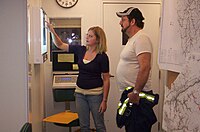
Photo from wikipedia
Study Objectives: Patients infected with SARS-CoV-2 who are evaluated in the emergency department but well enough to go home are still at risk for clinical deterioration. They may benefit from… Click to show full abstract
Study Objectives: Patients infected with SARS-CoV-2 who are evaluated in the emergency department but well enough to go home are still at risk for clinical deterioration. They may benefit from a program to monitor oxygen levels at home using portable pulse oximeter devices. Our study aims to evaluate patient engagement in and compliance with a home pulse oximetry monitoring program. The results of this study will be important to inform development and operationalization of remote patient monitoring programs. Methods: This was a single center, prospective pilot study of patients who presented to the ED or urgent care for symptoms consistent with SARS-CoV-2 infection and were considered to have some risk of clinical deterioration and thus could benefit from home SpO2 monitoring. Subjects were given a portable pulse oximeter and diary. They were instructed to perform readings at rest and with exertion twice daily for 14 days. Patients also recorded the presence or absence of symptoms associated with COVID-19 and whether they required additional medical care due to worsening symptoms. Subjects were contacted daily to obtain the recorded data. If contact could not be made with 3 attempts on each of 3 successive days, the subject was considered lost to follow up. The primary outcome of interest was patient engagement in the program defined as completion of the entire 14-day assessment. Secondary outcomes included patient compliance with performing the SpO2 readings and the proportion of subjects who had worsening clinical status requiring medical evaluation. Patient compliance was calculated as a percentage of completed readings out of the total number of possible readings. The difference in engagement and compliance rates between COVID-positive and COVID-negative patients was calculated using the Pearson Chi-squared test and Mann-Whitney U test, respectively. Results: Fifty patients were enrolled in the study with 3 screen failures. The remaining 47 were included in the final analysis. All patients received a qualitative test for detection of SARS-CoV-2;27 (57.4%) patients tested positive. Overall, engagement in the program was 46.8% with no significant difference between COVID- positive and COVID-negative groups (48.15% vs 45 %, p = 0.831). Median compliance was 42.9% (IQR 22.22 78.57) with compliance of 50.0% (IQR 20 - 85.71) and 42.86% (IQR 22.92 - 76.44) for COVID-positive and COVID-negative groups, respectively (p= 0.838). A total of 4 patients required additional medical care during the study period. Of those, two sought medical attention after advisement by the study team members due to decreasing SpO2 levels. Conclusion: Our study demonstrated that there was limited engagement and compliance in a 14-days home pulse oximetry monitoring program. A positive SARS-CoV-2 test did not predict a higher likelihood of engagement or compliance. Our program was helpful in detecting worsening SpO2 levels in two patients who sought medical care and were admitted for further management. These results support the use of home pulse oximetry monitoring;however, design of programs should focus on increasing patient engagement and compliance.
Journal Title: Annals of Emergency Medicine
Year Published: 2021
Link to full text (if available)
Share on Social Media: Sign Up to like & get
recommendations!